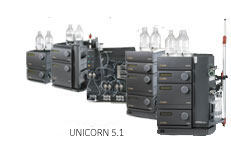

|
|

|
|
Gradients and eluent concentrations
|

|
|
Introduction

|
Gradient instructions
are given in the Text Instructions editor
of the Method Editor. This
type of instruction defines gradients and immediate changes in eluent
concentration.
|
|
|
|
|
Parameters of the Gradient

|
The
table below shows the two parameters of the Gradient instruction:
|
Parameter
|
Description
|
|
Target
|
Final eluent composition expressed in % eluent B.
|
|
Length
|
Duration of the gradient.
|
|
|
|
|
|
Example of a Gradient instruction

|
The starting point for the Gradient is
always the current eluent composition. The instruction can be read
as follows: “form a Gradient to
reach Target after Length”.
Example of instruction
10.00
Gradient 50{%B}, 20{base}
The example instruction above forms a gradient to 50%B (Target) starting at breakpoint
10 with duration 20 method base units (Length). The
example instruction will finish at breakpoint 30. If the current
eluent concentration is greater than 50%, the gradient will be negative.
|
|
|
|
|
How to form a step gradient instruction

|
A
step gradient is an immediate change in eluent composition. To form
a step gradient, set the Length parameter
to 0 in the Gradient instruction.
Example of instruction
10.00
Gradient 50{%B}, 0{base}
The example instruction above forms a step from the current
eluent composition to 50%B at breakpoint 10. The method continues
with 50%B.
|
|
|
|
|
Breakpoints for gradients

|
The
breakpoint for a Gradient instruction
defines the time or volume (according to method base) for the start
of the gradient. A gradient with a non-zero duration occupies time
and volume in the method, and breakpoints for other instructions
may be set to occur before the gradient is completed. For most instructions,
the instruction is simply carried out at the requested breakpoint, while
the gradient is forming.
|
|
|
|
|
Instructions that affect gradients

|
The
table below describes the instructions that affect the gradient:
|
Instruction
|
Effect
|
|
Gradient
|
A new gradient will start at the requested breakpoint.
Any remaining duration of the previous gradient is ignored.
|
|
Flow
|
The eluent flow rate will change at the requested breakpoint.
If the current base is volume or column volume, the duration of
the gradient will be changed. If the method base is time, the volume
of the gradient will be changed.
|
|
End_Method
|
The whole method will stop, interrupting the gradient.
|
|
End_Block
|
The gradient formation will continue uninterrupted unless
a new Gradient instruction
is issued in the next block. For example, this means that a block
can be called conditionally during gradient formation without interrupting
the gradient.
|
|
|
|
|
|
Gradients with variable length

|
For many purposes,
it can be useful to define the length of the gradient as a variable.
When this is done, breakpoints for instructions issued during or
after the gradient in the same block are automatically shifted in
proportion to the length of the gradient, with the same functionality
as Change in the Text Instructions editor.
|
|
|
|
|
Instruction after a gradient

|
Any instruction that you want to insert after a gradient should
be placed after the combined breakpoint and gradient length, since
gradients function over time.
|
|
|
|
2005-06-15
|
|
|
